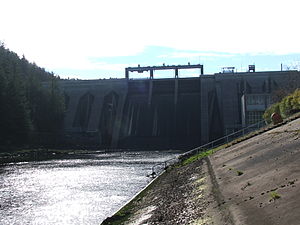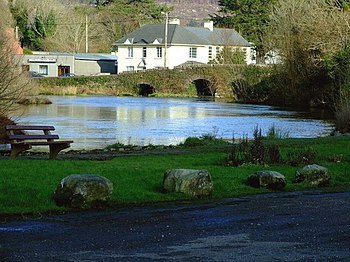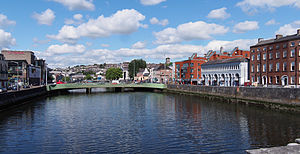River Lee
The River Lee is a river in County Cork. It rises in the Shehy Mountains on the western border of the county and flows eastwards through Cork, where it splits in two for a short distance, creating an island on which Cork's city centre is built, and empties into the Celtic Sea at Cork Harbour on the south coast, one of the largest natural harbours in the world. The catchment area of the River Lee is 484 sq. miles.[1] The long-term average flow rate of the River Lee is 8,886 gallons per second[1]
A hydro-electric scheme was built on the river, upstream from Cork, and this part of the river now contains the Carrigadrohid and Inniscarra reservoirs. The river is crossed by 42 bridges, 29 of which are in Cork, and one tunnel. The river also provides a five-mile stretch of salmon fishing.
Contents
Description
Sources
The River Lee has its source in the Shehy Mountains near Gougane Barra, where there is a forest park, chapel, hotel, and shop.
Course
The Lee flows from the lake of Gougane Barra as a fast paced torrent, but by the town of Ballingeary it eases and flows into Lough Allua. Departing the lough, running east, it again becomes a rapid flow before running into the Inniscarra reservoir created by Inniscarra Dam. Moving on, it flows down from the dam, in normal conditions a gentle river until it comes to Ballincollig Weir in Ballincollig Park; here it is dangerous to swimmers when in high water. The Lee then flows into the city under Inniscarra Bridge and flows parallel to the Carrigrohane road. Along this section gauges monitor the water levels from the Inniscarra Dam. The river flows over the Lee weir and then is split into the north and south channel at a sluice (it historically occupied the city area in a maze of channels). This area is popular for recreation, kayaking and fishing. The two channels join again at the Cork docks and enter the extensive estuary and harbour, south of Glanmire, passing either side of Great Island (Cobh lies on the south coast) to fill the outer harbour, and reaching the open sea between Whitegate and Crosshaven.
Tributaries
The upper tributaries of the Lee include the large Sullane River from near Ballyvourney (tributaries include the Foherish and Laney Rivers), the small Buinea and Glashagariff Rivers, the River Dripsey and its tributary the Ryelane, the River Bride from Crookstown via Ovens, and the Shournagh River (formed from the Blarney and Martin Rivers, and the Owennagearagh River; historically may have been the Awbeg River). City area tributaries include the combined Maglin (from Ballincollig) and Curraheen (occasionally Curragheen) Rivers, capturing the Glasheen River also and joining at the western end of the UCC complex, and the Kiln River which joins by the Christy Ring Bridge in the city centre, a little west of St Patrick's Bridge[2] (formed in turn from another Bride River and the Kilnap or Glennamought River, later joined by the Glen River). Estuarine tributaries include Glashaboy River, passing Glanmire (main tributaries the Black Brook, Cloghnageshee River and Butterstown River), the Douglas or Tramore River (joined by the Trabeg River as it flows into the Douglas Channel, its estuary) which drains parts of the southern city, Owennacurra River (joined by the Dungurney River at Midleton), and the Owenaboy River almost at the final mouth of the outer Lee estuary (the Liberty Stream joins this river, with significant flows from Cork Airport).[3]
Recreation
Recreation activities on the Lee include sailing, from a sailing club based on Inniscarra lake, where people also swim. There is a kayak club based on the Lee Road. Water skiing also takes place on Inniscarra lake and several rowing clubs are based on the Lee including the "Lee Rowing Club" and "Shandon Boat Club". Anglers are common at the banks of the Lee Fields.
Flooding

Tidal considerations, combined with low-lying urban developments, and later dam management contribute to repeated flooding events on the Lee.[4][5][6][7] For example, specific streets in Cork city centre have been affected by floods more than 100 times since the mid-19th century.[8]
In late 2009 the river flooded, along with many others in Britain and Ireland, causing some of the most significant damage in Cork for a number of centuries. The Lee Water Station was forced to shut down after being submerged under 20 feet of water, and resulted in 40% of the city (50,000 people) being without running water for over one week. [9]
University College Cork was also flooded extensively, resulting in lectures being canceled throughout the week.[10] There was severe damage to the university's then newly built IT building, the Western Gateway Building, situated next to the river, with a 300-seat auditorium flooded to near ceiling height.[11]
To prevent issues upstream, the Electricity Supply Board made a controversial decision to release water from the Inniscarra hydro-electric dam. This released 526 tons of water per second into the already flooded river, raising the flood to five feet in parts of the city centre. The ESB insisted this was an essential move, and if water had not been released, the flooding would have been much worse.[12]
References
- ↑ 1.0 1.1 South Eastern River Basin District Management System. Page 38
- ↑ Insurance Plan of Cork (Goad Map), 1897, retrieved 2 Jan 2013 from Cork Past & Present - Goad Key
- ↑ Lee CFRAMS: Hydrology Report, Halcrow Group Ireland for the OPW, Cork: 2008
- ↑ http://www.opw.ie/en/leecframs/floodmaps/
- ↑ https://web.archive.org/web/20160508223553/http://www.lee.cfram.com/
- ↑ http://www.lee.cfram.com/downloads/documents/REP007_FinalReport.pdf
- ↑ http://www.lowerleefrs.ie/index.php/site/index
- ↑ http://www.corkpastandpresent.ie/places/oliverplunkettstreet/floodinginoliverplunkettstreet/
- ↑ "City facing bill of €100m to fix flood damage". Irish Independent. 2009-11-23. http://www.independent.ie/national-news/city-facing-bill--of-8364100m-to-fix--flood-damage-1951167.html. Retrieved 2010-01-27. Independent.ie's summary on the flood
- ↑ "University College Cork (UCC): Weather Notifications". http://www.ucc.ie/en/flood/. Retrieved 2010-01-27. UCC's Notification webpage on the floods
- ↑ "Report-on-Major-Flood-Damage.pdf". http://www.ucc.ie/en/media/Report-on-Major-Flood-Damage.pdf. Retrieved 2010-01-27. PDF file on the damages
- ↑ Riegel, Ralph; Melia, Paul (2009-12-08). "ESB stands by decision to release water into city centre". Irish Independent. http://www.independent.ie/national-news/esb-stands-by-decision-to-release-water-into-city-centre-1966996.html. Retrieved 2010-01-27. Independent.ie News article on ESB's decision
Outside links
| ("Wikimedia Commons" has material about River Lee) |

